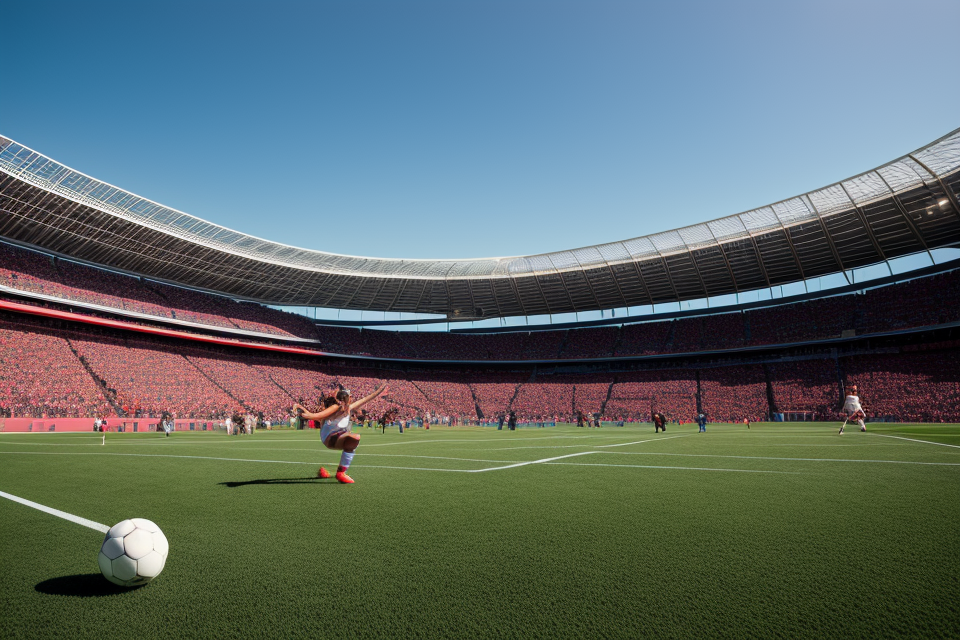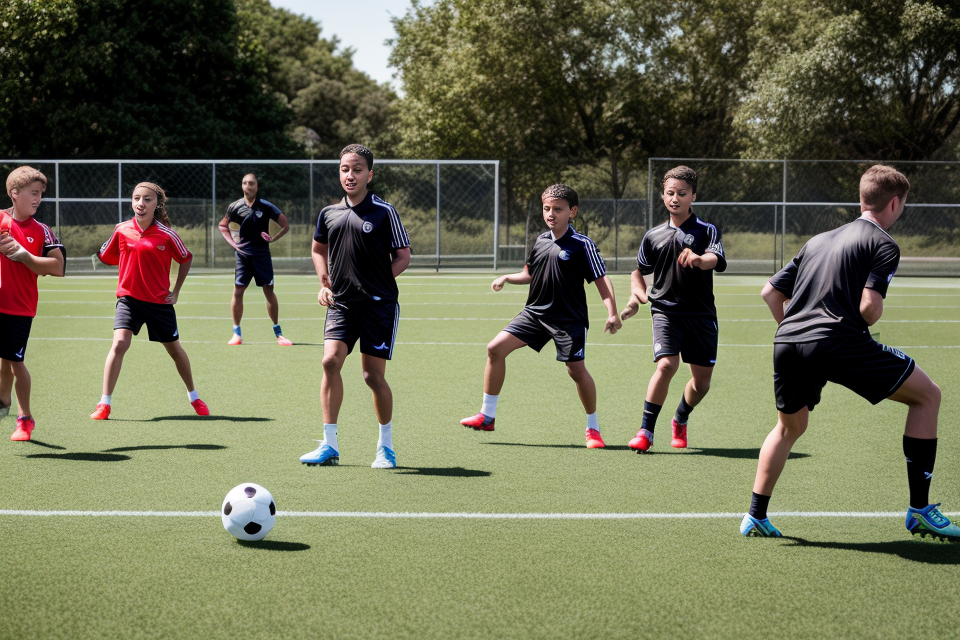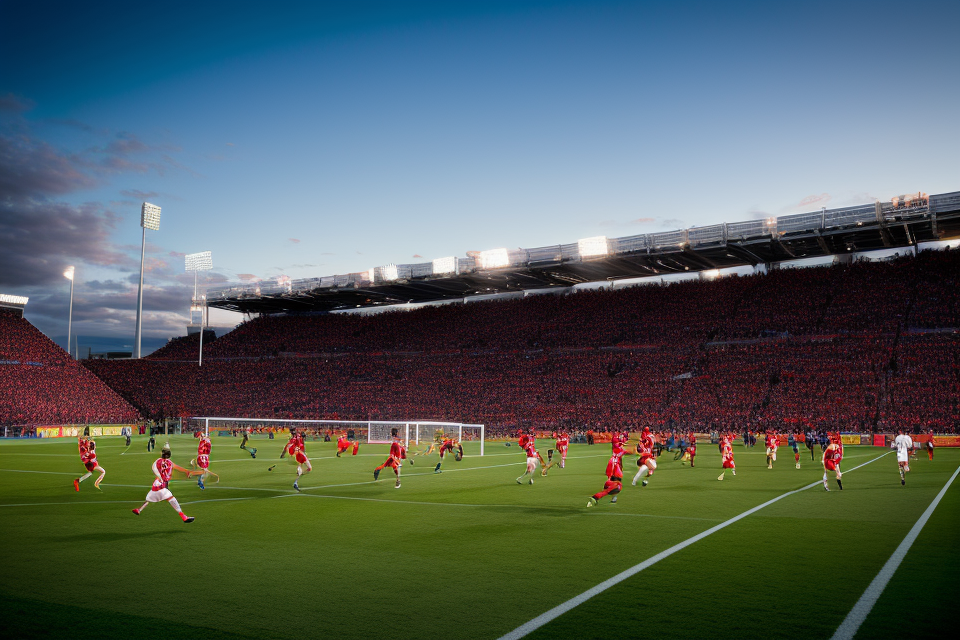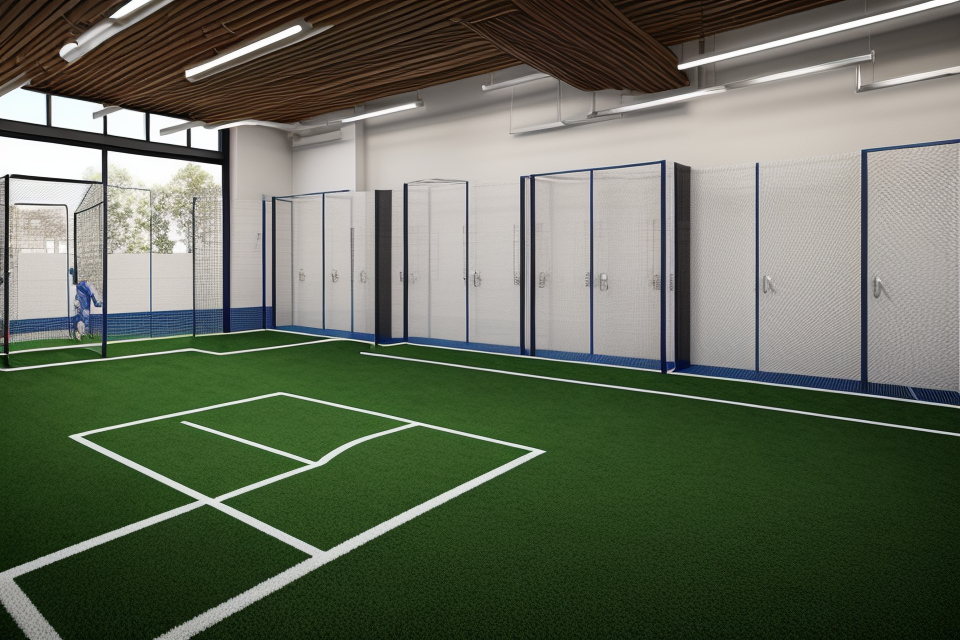Soccer is a high-intensity sport that requires a combination of strength, speed, endurance, and agility. To perform at your best on the field, it’s essential to maintain a high level of fitness. In this article, we’ll explore some essential fitness tips for soccer players that can help you master your performance and take your game to the next level. From improving your cardiovascular endurance to building your strength and agility, these tips will help you achieve the physical conditioning necessary to excel on the field. So, let’s get started and discover how you can become a soccer powerhouse!
Developing a Comprehensive Fitness Plan for Soccer
Assessing Your Current Fitness Level
Before beginning any fitness plan, it is essential to assess your current fitness level. This step will help you understand your strengths and weaknesses, which will guide you in setting realistic goals. There are two main methods to assess your current fitness level: conducting a fitness test and evaluating your performance during a soccer match.
Conducting a Fitness Test
Conducting a fitness test is a reliable way to measure your cardiovascular endurance, muscular strength, and endurance, and flexibility. There are several fitness tests that you can perform, such as the beep test, shuttle run, and the sit-and-reach test. It is important to choose tests that are specific to soccer and that will provide accurate results.
Evaluating Your Performance During a Soccer Match
Another way to assess your current fitness level is by evaluating your performance during a soccer match. This method is more practical and specific to soccer since it simulates the actual demands of the sport. To evaluate your performance, you can analyze your playing time, number of ball possessions, tackles, interceptions, and passes completed.
It is also important to pay attention to your body’s feedback during and after the match. If you feel fatigued, short of breath, or experience muscle soreness, it may indicate that your fitness level needs improvement.
In conclusion, assessing your current fitness level is a crucial step in developing a comprehensive fitness plan for soccer. Conducting a fitness test and evaluating your performance during a soccer match are two effective methods to measure your cardiovascular endurance, muscular strength and endurance, and flexibility. By understanding your strengths and weaknesses, you can set realistic goals and develop a tailored fitness plan that will help you improve your soccer performance.
Creating a Training Schedule
Allocating Time for Various Aspects of Training
To develop a comprehensive fitness plan for soccer, it is essential to allocate time for various aspects of training. This includes:
- Technical Training: Developing ball control, dribbling, passing, and shooting skills.
- Tactical Training: Understanding the game and developing strategies to outsmart opponents.
- Physical Training: Developing strength, endurance, and agility.
- Mental Training: Developing focus, confidence, and resilience.
Each of these aspects of training is critical to achieving optimal performance on the field. It is essential to allocate time for each aspect of training in the training schedule.
Incorporating Rest and Recovery Days
In addition to allocating time for various aspects of training, it is also important to incorporate rest and recovery days into the training schedule. Rest and recovery days allow the body to repair and rebuild muscle tissue, which is essential for optimal performance.
It is recommended to have at least one rest day per week, and to include light recovery activities such as yoga or stretching on these days.
Adapting to Different Training Phases
As the soccer season progresses, it is important to adapt the training schedule to different training phases. This includes:
- Pre-season: Building a base of fitness and preparing for the upcoming season.
- In-season: Maintaining fitness and preparing for upcoming games.
- Post-season: Recovering from the season and preparing for the next one.
It is important to adapt the training schedule to each of these phases to ensure that the player is optimally prepared for the demands of the season.
Building Strength and Endurance
Resistance Training
Resistance training is a crucial aspect of any soccer player’s fitness routine. It helps to improve strength, power, and overall athletic performance on the field. Here are some key exercises that can be incorporated into a resistance training program:
- Squats: These are a great exercise for developing lower body strength and power. They work the glutes, quads, and hamstrings, which are all important muscles for soccer players.
- Deadlifts: These are another excellent exercise for developing lower body strength. They work the hamstrings, glutes, and lower back muscles, which are essential for maintaining proper form and balance on the field.
- Bench press: This exercise works the chest, shoulders, and triceps, which are important muscles for soccer players. It helps to improve upper body strength and power, which is essential for pushing off and making powerful tackles.
- Pull-ups: These are a great exercise for developing back and bicep strength. They help to improve upper body strength and power, which is important for maintaining proper form and balance on the field.
When designing a resistance training program, it’s important to keep in mind the specific needs of a soccer player. This means focusing on exercises that target the muscles used most in soccer, such as the legs, core, and upper body. It’s also important to gradually increase the intensity and difficulty of the exercises over time to avoid plateauing and to continue making progress.
Additionally, it’s important to allow for proper recovery between workouts. This means giving the muscles time to rest and repair themselves, which is essential for maximizing muscle growth and preventing injury. A well-designed resistance training program can help soccer players to improve their overall fitness and athletic performance on the field.
Cardiovascular Training
- The role of cardiovascular fitness in soccer performance
Cardiovascular fitness is crucial for soccer players as it allows them to maintain high intensity throughout the game. It helps in improving endurance, speed, and agility, which are essential skills for a soccer player. Cardiovascular fitness is measured by VO2 max, which is the maximum amount of oxygen that the body can consume during exercise. The higher the VO2 max, the better the cardiovascular fitness.
- Developing a cardiovascular training plan
A cardiovascular training plan should be tailored to the individual needs of the player. It should include a combination of high-intensity interval training, moderate-intensity continuous training, and low-intensity steady-state training. The training plan should also include a warm-up and cool-down period to prevent injury.
- Progressive training methods for improving endurance
Progressive training methods involve gradually increasing the intensity and duration of training over time. This can be achieved by increasing the number of repetitions, duration, or distance of each exercise. For example, a player can start with a 1-mile run and gradually increase it to 3 miles over several weeks. This type of training helps the body to adapt to the demands of the game and improve endurance.
It is important to note that cardiovascular training should not be the only type of training that a soccer player engages in. Resistance training, flexibility training, and recovery are also essential components of a comprehensive fitness program for soccer players.
Improving Speed and Agility
Developing Explosiveness
Explosiveness is a crucial aspect of soccer performance, as it enables players to accelerate, change direction quickly, and deliver powerful shots. To develop explosiveness, it is essential to incorporate specific exercises into your training regimen that target the muscles used in soccer movements.
Some key exercises for developing explosiveness include:
- Plyometrics: Plyometric exercises involve explosive movements that use the stretch-shortening cycle to enhance power output. Examples include box jumps, squat jumps, and depth jumps.
- Jump training: Jump training is a great way to develop explosiveness in the lower body. Exercises such as broad jumps, vertical jumps, and lateral jumps can help improve leg power and explosiveness.
- Resistance training: Resistance training with weights or resistance bands can help build explosiveness by developing muscular strength and power. Exercises such as lunges, squats, and deadlifts can be effective in developing explosiveness in the legs.
To improve start and acceleration, it is important to focus on the following techniques:
- Dynamic stretching: Dynamic stretching involves active movements that prepare the muscles for explosive action. Examples include leg swings, arm circles, and hip swings.
- Acceleration drills: Acceleration drills involve short bursts of maximum effort, followed by active recovery. Examples include shuffle drills, footfire drills, and agility ladder drills.
- Proper running form: Maintaining proper running form can help maximize the efficiency of your movements and reduce the risk of injury. Key elements of good running form include a tall posture, relaxed shoulders, and a midfoot strike.
By incorporating these exercises and techniques into your training regimen, you can develop the explosiveness needed to excel on the soccer field.
Enhancing Agility
Importance of Agility in Soccer
In soccer, agility refers to the ability of a player to rapidly change direction and move with ease around other players on the field. It is a crucial skill that allows players to evade opponents, make quick decisions, and ultimately gain an advantage over their opponents.
Developing Quick Change-of-Direction Skills
Developing quick change-of-direction skills involves improving the strength and flexibility of the muscles in the legs, hips, and core. This can be achieved through a combination of exercises such as plyometrics, agility drills, and balance exercises.
Drills for Improving Agility and Footwork
There are several drills that can help improve agility and footwork, including:
- Cone drills: These drills involve running through a series of cones placed in a zig-zag pattern, which requires quick changes of direction and fast footwork.
- Shuffle drills: These drills involve shuffling sideways while maintaining balance and control, which helps improve footwork and agility.
- Jumping and landing drills: These drills involve jumping and landing in different directions, which helps improve the strength and flexibility of the muscles in the legs, hips, and core.
Overall, incorporating these drills into a training routine can help improve agility and footwork, which are essential skills for success in soccer.
Injury Prevention and Mobility Training
Identifying Common Soccer Injuries
Understanding the most common soccer injuries is crucial for players and coaches to implement effective preventive measures. Here’s a closer look at some of the most prevalent soccer injuries:
- Ankle Sprains
Ankle sprains are among the most frequently occurring soccer injuries, often resulting from sudden changes in direction or unstable playing surfaces. These injuries can range from mild to severe, with the anterior talofibular ligament (ATFL) being the most commonly affected. - Hamstring Strains
Hamstring strains are another common injury in soccer, typically occurring due to overexertion, poor flexibility, or inadequate warm-up. These strains can range from a minor pull to a complete tear, significantly impacting a player’s performance and recovery time. - Groin Strain
Groin strains are common in soccer players, particularly those involved in high-intensity activities such as sprinting and changing direction. These injuries often occur due to overstretching or tearing of the adductor muscles and can be either acute or chronic. - Muscle Strain
Muscle strains can occur in various parts of the body, including the quadriceps, hamstrings, calf muscles, and hip flexors. These injuries typically result from overexertion, insufficient warm-up, or poor technique, and can range from mild to severe. - Concussions
Head injuries, such as concussions, are a significant concern in soccer, particularly due to headers and high-impact collisions. Recognizing the signs of a concussion and implementing proper return-to-play protocols are essential for minimizing long-term damage. - Stress Fractures
Stress fractures, often affecting the lower extremities, can result from repetitive stress or inadequate bone strength. These injuries can be caused by high-intensity training, rapid increases in training load, or inadequate recovery time.
Understanding these common soccer injuries allows players and coaches to take proactive measures in prevention, such as implementing proper warm-up and stretching routines, gradually increasing training intensity, and ensuring adequate recovery time.
Flexibility and Mobility Training
Importance of Flexibility and Mobility for Soccer Players
In soccer, players are required to make quick movements, change direction, and perform various skills, such as kicking, jumping, and running. These movements can put a lot of stress on the body, making it essential for players to have good flexibility and mobility.
Good flexibility and mobility can help prevent injuries, improve performance, and increase the range of motion in the joints. It can also help players maintain proper alignment and balance, which is crucial for optimal movement and preventing injuries.
Stretching and Mobility Exercises for Key Areas
There are several stretching and mobility exercises that soccer players can incorporate into their routine to improve their flexibility and mobility. Some of the key areas to focus on include the hamstrings, quadriceps, hip flexors, calves, and ankles.
- Hamstrings: Hamstring stretches can help improve flexibility in the back of the thigh and can prevent injuries such as hamstring strains.
- Quadriceps: Quadriceps stretches can help improve flexibility in the front of the thigh and can prevent injuries such as quadriceps strains.
- Hip flexors: Hip flexor stretches can help improve flexibility in the front of the hip and can prevent injuries such as groin strains.
- Calves: Calf stretches can help improve flexibility in the lower leg and can prevent injuries such as calf strains.
- Ankles: Ankle stretches can help improve flexibility in the ankle and can prevent injuries such as ankle sprains.
Incorporating Mobility Training into Your Routine
Incorporating flexibility and mobility exercises into your routine can help improve your overall performance on the soccer field. It is important to include these exercises in your warm-up and cool-down routines, as well as incorporating them into your regular training sessions.
Consistency is key when it comes to mobility training. Set aside time each day to focus on stretching and mobility exercises, and gradually increase the intensity and duration of your workouts over time. This will help improve your flexibility and mobility, and ultimately, your performance on the soccer field.
Nutrition and Hydration for Optimal Performance
Fueling Your Body for Soccer
Proper nutrition is essential for soccer players to perform at their best. The energy demands of soccer are high, and players need to fuel their bodies with the right nutrients to maintain their physical and mental performance throughout the game. Understanding the energy systems and their fuel sources is crucial for soccer players to optimize their performance.
The human body has three energy systems: the phosphagen system, glycolytic system, and oxidative system. The phosphagen system provides energy for short-term, high-intensity activities such as sprinting and jumping. The glycolytic system is used for moderate-intensity activities and provides energy through the breakdown of glucose. The oxidative system is used for low-intensity activities and provides energy through the oxidation of fat and carbohydrates.
For soccer players, the glycolytic system is the most important energy system. This system provides energy for the high-intensity bursts of activity that are common in soccer, such as sprinting, jumping, and changing direction. To fuel the glycolytic system, players need to consume carbohydrates, which are the primary fuel source for this energy system.
It is important for soccer players to consume carbohydrates before, during, and after games and training sessions. Good sources of carbohydrates include whole grains, fruits, vegetables, and legumes. It is also important for players to stay hydrated during games and training sessions. Dehydration can negatively affect physical performance, concentration, and decision-making.
To maintain optimal hydration, players should drink water or sports drinks that contain electrolytes before, during, and after games and training sessions. It is also important for players to monitor their urine color and frequency to ensure they are staying adequately hydrated.
In summary, proper nutrition is essential for soccer players to perform at their best. The glycolytic system is the most important energy system for soccer, and players need to fuel this system with carbohydrates. It is also important for players to stay hydrated by drinking water or sports drinks before, during, and after games and training sessions.
Managing Weight and Diet
The Role of Body Weight in Soccer Performance
In soccer, players need to be at an optimal weight to perform at their best. Being underweight or overweight can negatively impact a player’s performance on the field. For example, being underweight can lead to fatigue and decreased endurance, while being overweight can make it difficult for players to move quickly and change direction.
Balancing Energy Intake and Expenditure
To maintain a healthy weight, it’s important for soccer players to balance their energy intake and expenditure. This means consuming the right amount of calories to support their physical activity level and avoiding excessive calorie consumption. It’s also important to be mindful of the quality of calories consumed, focusing on nutrient-dense foods that support optimal performance.
Creating a Balanced Diet for Soccer Players
A balanced diet for soccer players should include a variety of nutrient-dense foods from all food groups, including fruits, vegetables, whole grains, lean protein sources, and healthy fats. This can help ensure that players are getting the nutrients they need to support their physical activity level and maintain a healthy weight.
Additionally, soccer players should consider incorporating specific nutrients into their diet that can support their performance on the field. For example, consuming adequate amounts of carbohydrates can help support endurance and energy levels, while including protein-rich foods can help build and repair muscle tissue.
Overall, managing weight and diet is an important aspect of mastering soccer performance. By balancing energy intake and expenditure and consuming a balanced diet that includes nutrient-dense foods from all food groups, soccer players can support their physical activity level and maintain a healthy weight to perform at their best on the field.
Mental and Tactical Preparation
Developing a Winning Mindset
In order to become a top-performing soccer player, it is crucial to develop a winning mindset. This mindset involves a combination of mental and emotional skills that enable players to stay focused, motivated, and resilient in the face of challenges. Here are some key elements of developing a winning mindset:
Understanding the mental aspects of soccer performance
The mental aspects of soccer performance are often overlooked, but they play a crucial role in determining how well a player performs on the field. These aspects include things like focus, concentration, motivation, confidence, and emotional regulation. By understanding these mental factors, players can learn to harness them in order to improve their performance.
Cultivating self-confidence and resilience
Self-confidence and resilience are essential mental qualities for soccer players. Self-confidence allows players to believe in their abilities and to take risks when necessary, while resilience enables them to bounce back from setbacks and adversity. Building these qualities requires practice, repetition, and a growth mindset.
Developing a winning mindset through visualization and goal-setting
Visualization and goal-setting are powerful tools for developing a winning mindset. Visualization involves mentally rehearsing key moments in a game or match, which can help players feel more confident and prepared. Goal-setting involves setting specific, measurable, achievable, relevant, and time-bound (SMART) goals for improvement, which can help players stay motivated and focused on their progress.
Overall, developing a winning mindset requires consistent effort and practice. By focusing on mental and emotional skills, players can enhance their performance on the field and achieve their full potential as soccer players.
Analyzing and Improving Tactics
Analyzing and improving tactics is a crucial aspect of soccer performance. This involves understanding the tactical aspects of the game, analyzing opponents and strategies, and developing effective teamwork and communication skills.
Understanding the tactical aspects of soccer
To analyze and improve tactics, it is important to have a deep understanding of the tactical aspects of soccer. This includes understanding the different formations, roles and responsibilities of players, and the principles of attack and defense. It is also important to understand the different tactics that can be used in different situations, such as set pieces and transitions.
Analyzing opponents and strategies
Another key aspect of analyzing and improving tactics is analyzing opponents and their strategies. This involves studying the opposition’s strengths and weaknesses, as well as their playing style and formation. By understanding the opposition’s tactics, players can develop effective strategies to counter their opponents and gain an advantage on the field.
Developing effective teamwork and communication skills
Effective teamwork and communication skills are also essential for analyzing and improving tactics. This involves working closely with teammates to develop a shared understanding of the tactics and strategies being used, as well as communicating effectively on the field. By developing strong teamwork and communication skills, players can work together more effectively and achieve better results on the field.
FAQs
1. What are the essential fitness components for soccer players?
Soccer is a sport that requires a combination of various fitness components, including cardiovascular endurance, muscular strength and endurance, speed, agility, coordination, and flexibility. To excel in soccer, players need to work on all these aspects to ensure they can perform at their best during matches.
2. How can soccer players improve their cardiovascular endurance?
Cardiovascular endurance is crucial for soccer players as it helps them maintain high intensity throughout the match. To improve cardiovascular endurance, players can engage in activities such as running, cycling, or swimming for at least 30 minutes a day, five times a week. Additionally, incorporating interval training, which involves short bursts of high-intensity exercise followed by periods of rest, can also help improve cardiovascular endurance.
3. What are the best exercises to improve muscular strength and endurance for soccer players?
Soccer players need to have strong muscles in their legs, core, and upper body to perform various movements on the field. Exercises such as squats, lunges, deadlifts, push-ups, and pull-ups can help improve muscular strength and endurance. It is essential to incorporate strength training into the fitness routine at least two to three times a week, focusing on different muscle groups each session.
4. How can soccer players improve their speed and agility?
Speed and agility are crucial for soccer players as they need to be able to quickly change direction and move around the field. To improve speed and agility, players can engage in exercises such as plyometrics, which involve jumping and landing movements, and agility drills, which involve moving around cones or other obstacles. Additionally, incorporating sprint training, which involves short bursts of high-speed running, can also help improve speed and agility.
5. How important is flexibility and mobility for soccer players?
Flexibility and mobility are essential for soccer players as they need to be able to perform various movements on the field without getting injured. Incorporating stretching and mobility exercises into the fitness routine can help improve flexibility and mobility. Additionally, players can also benefit from incorporating yoga or Pilates into their fitness routine to improve their flexibility and mobility.
6. How many hours should soccer players train per week to achieve optimal performance?
The amount of training required for soccer players can vary depending on their current fitness level, position on the field, and the level of competition they are playing at. However, as a general guideline, soccer players should aim to train for at least two to three hours per day, five to six days a week. This includes both team training and individual fitness training.
7. What should soccer players eat to fuel their performance on the field?
Eating a balanced diet that includes a mix of carbohydrates, protein, and healthy fats is essential for soccer players to fuel their performance on the field. Additionally, players should also focus on consuming nutrient-dense foods such as fruits, vegetables, and whole grains to provide their bodies with the necessary vitamins and minerals for optimal performance. It is also important for players to stay hydrated by drinking plenty of water throughout the day.



